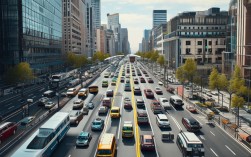初中级水平
这篇作文结构清晰,语言简单,适合英语初学者或初中生使用。 The Future of Cars: Self-Driving Vehicles**

The world is changing, and so is the way we travel. One of the biggest changes is the development of self-driving cars. These are cars that can drive themselves without a person. They use cameras, sensors, and computers to see the road and make decisions.
There are both good things and bad things about self-driving cars. On the one hand, they can make our roads much safer. Human drivers sometimes make mistakes, like texting or feeling tired. But self-driving cars do not get tired or distracted. This could lead to fewer accidents. On the other hand, some people are worried about losing their jobs. If everyone uses self-driving cars, there might be no need for taxi or truck drivers.
In my opinion, self-driving cars are the future. They will be safer and can help people who cannot drive, such as the old or the disabled. Of course, we need to solve problems like job loss. But with time and careful planning, I believe self-driving cars will make our lives better and easier.
【重点词汇 Key Vocabulary】
- Self-driving car: 无人驾驶汽车
- Sensor: 传感器
- Distracted: 分心的
- Accident: 事故
- Lose one's job: 失去工作
- Disabled: 残疾的
- Careful planning: 周密的计划
【中文翻译 Chinese Translation】 汽车的未来:无人驾驶汽车**
世界正在变化,我们出行的方式也在改变,其中最大的变化之一就是无人驾驶汽车的发展,这是一种无需人驾驶、可以自己行驶的汽车,它们使用摄像头、传感器和计算机来观察道路并做出决策。
无人驾驶汽车既有好处也有坏处,它们可以让我们的道路安全得多,人类驾驶员有时会犯错,比如发短信或感到疲劳,但无人驾驶汽车不会疲劳也不会分心,这可能会减少交通事故,有些人担心会因此失业,如果每个人都使用无人驾驶汽车,可能就不需要出租车或卡车司机了。
在我看来,无人驾驶汽车是未来的趋势,它们会更安全,也能帮助那些不能开车的人,比如老人或残疾人,我们还需要解决失业之类的问题,但我相信,随着时间的推移和周密的规划,无人驾驶汽车会让我们的生活变得更好、更轻松。
中高级水平
这篇作文逻辑更严谨,用词更丰富,适合高中生或大学生使用。 The Double-Edged Sword of Autonomous Vehicles**
The advent of autonomous vehicles (AVs) represents one of the most transformative technological shifts of the 21st century. Promising a future of enhanced safety, increased efficiency, and unparalleled convenience, self-driving cars are rapidly moving from the realm of science fiction to reality. However, this revolutionary technology is a double-edged sword, presenting a complex tapestry of opportunities and significant challenges that society must carefully navigate.
The primary argument in favor of AVs is their potential to drastically reduce road accidents. It is estimated that over 90% of traffic collisions are caused by human error, including distraction, fatigue, and intoxication. By eliminating the fallible human element from the equation, autonomous systems, with their 360-degree perception and instantaneous reaction times, could theoretically create a transportation utopia. Furthermore, AVs promise to optimize traffic flow, reduce congestion, and provide newfound mobility for the elderly, disabled, and those unable to drive.
Conversely, the widespread adoption of AVs raises profound concerns. The most pressing issue is the potential displacement of millions of workers whose livelihoods depend on driving, such as truckers, taxi drivers, and delivery personnel. The ethical dilemmas posed by "machine morality" are equally troubling. In an unavoidable accident, how should a self-driving car be programmed to react? Should it prioritize the safety of its passengers or pedestrians? These questions have no easy answers and require robust ethical frameworks. Additionally, the vulnerability of these systems to hacking and cybersecurity threats poses a serious risk to public safety.
In conclusion, while the promise of autonomous vehicles is alluring, we must proceed with cautious optimism. The transition to a world dominated by AVs will not be seamless. It demands a collaborative effort from governments, tech companies, and the public to establish comprehensive regulations, retrain the workforce, and build public trust. Only by thoughtfully addressing these multifaceted challenges can we truly harness the immense potential of this technology for the betterment of society.
【重点词汇 Key Vocabulary】
- Autonomous vehicle (AV): 无人驾驶汽车
- Transformative: 改变性的,变革的
- Double-edged sword: 双刃剑
- Unparalleled convenience: 无与伦比的便利
- Fallible human element: 易犯错的人类因素
- Utopia: 乌托邦,理想国
- Displacement: (职业) 替换,取代
- Ethical dilemmas: 伦理困境
- Hacking: 黑客攻击
- Cautious optimism: 谨慎的乐观
- Collaborative effort: 协作努力
- Comprehensive regulations: 全面的法规
【中文翻译 Chinese Translation】 无人驾驶汽车这把双刃剑**
无人驾驶汽车的出现代表了21世纪最具变革性的技术转变之一,它承诺了一个更安全、更高效、无比便利的未来,无人驾驶汽车正迅速从科幻领域走向现实,这项革命性的技术是一把双刃剑,它呈现出一幅由巨大机遇和严峻挑战构成的复杂画卷,社会必须审慎地应对。
支持无人驾驶汽车的主要论据是它们有潜力大幅减少道路交通事故,据估计,超过90%的交通事故是由人为错误造成的,包括分心、疲劳和酒驾,通过从方程式中消除易犯错的人类因素,无人驾驶系统凭借其360度的感知能力和瞬时反应时间,理论上可以创造一个交通乌托邦,无人驾驶汽车有望优化交通流量、减少拥堵,并为老年人、残疾人以及无法驾驶的人提供全新的出行方式。
相反,无人驾驶汽车的广泛普及也引发了深远的担忧,最紧迫的问题是,数百万以驾驶为生的工人可能会因此失业,例如卡车司机、出租车司机和送货员,由“机器道德”引发的伦理困境同样令人不安,在一场不可避免的事故中,无人驾驶汽车应如何被编程做出反应?它应该优先考虑乘客还是行人的安全?这些问题没有简单的答案,需要建立坚实的伦理框架,这些系统易受黑客攻击和网络威胁的漏洞,对公共安全构成了严重风险。
尽管无人驾驶汽车的承诺很诱人,但我们必须谨慎乐观地推进,向一个由无人驾驶汽车主导的世界过渡不会一帆风顺,这需要政府、科技公司及公众的共同努力,以建立全面的法规、为劳动力提供再培训,并建立公众信任,只有通过深思熟虑地应对这些多方面的挑战,我们才能真正利用这项技术的巨大潜力来造福社会。
高级水平
这篇作文语言地道,论证深刻,适合英语水平很高的大学生或备考雅思/托福的学生。 Navigating the Labyrinth: The Societal Implications of Autonomous Vehicles**
The impending integration of autonomous vehicles (AVs) into the fabric of our daily lives is not merely an automotive evolution; it is a paradigm shift with far-reaching societal implications. This nascent technology, propelled by a confluence of advancements in artificial intelligence, sensor technology, and big data analytics, promises to redefine our relationship with transportation. While the utopian vision of zero-emission, accident-free mobility is compelling, a critical examination reveals a labyrinth of profound economic, ethical, and infrastructural challenges that demand rigorous scrutiny and proactive governance.
The most frequently touted benefit of AVs is the potential for a dramatic enhancement in public safety. Human fallibility, encompassing everything from momentary lapses in concentration to the scourge of impaired driving, is the principal cause of vehicular fatalities. AVs, equipped with superior sensor fusion and algorithmic decision-making, offer the tantalizing prospect of mitigating this human-centric risk. Moreover, the efficiency gains could be monumental, with optimized routing reducing congestion and fuel consumption, while AVs-as-a-Service (AVaaS) models could democratize mobility for non-drivers, fostering greater social inclusion.
However, this technological utopia is shadowed by significant societal disruptions. The most palpable threat is the potential decimation of entire professions. The livelihoods of millions—from long-haul truckers to taxi drivers—are contingent upon manual driving. The transition to an AV-dominated economy will necessitate not just job retraining but a fundamental restructuring of social safety nets and economic paradigms. Furthermore, the ethical quandaries are philosophically complex. The classic "trolley problem," wherein an AV must choose between two harmful outcomes, is a stark illustration of the unresolved moral calculus that underpins machine learning. Who is liable in the event of a collision—the manufacturer, the software developer, or the owner? This question of accountability remains legally ambiguous. Lastly, the digital divide presents a formidable challenge; the high cost of AV technology could exacerbate inequality, creating a mobility divide between the











